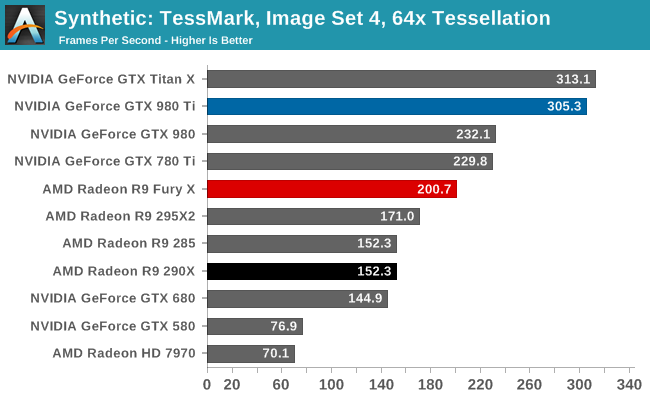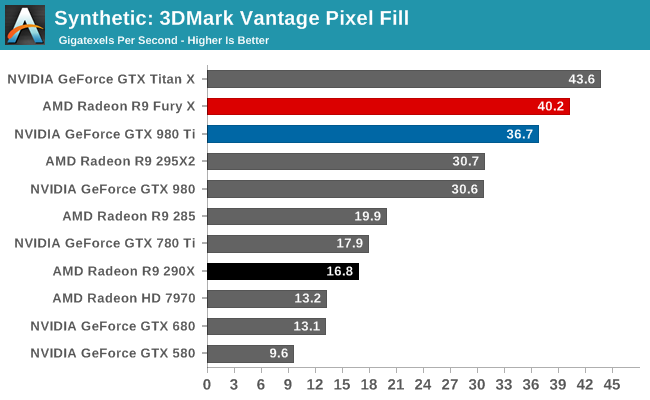The AMD Radeon R9 Fury X Review: Aiming For the Top
by Ryan Smith on July 2, 2015 11:15 AM ESTSynthetics
As always we’ll also take a quick look at synthetic performance. Since Fiji is based on the same GCN 1.2 architecture as Tonga (R9 285), we are not expecting too much new here.

First off we have tessellation performance. As we discussed in greater detail in our look at Fiji’s architecture, AMD has made some tessellation/geometry optimizations in GCN 1.2, and then went above and beyond that for Fiji. As a result tessellation performance on the R9 Fury X is even between than the R9 285 and the R9 290X, improving by about 33% in the case of TessMark. This is the best performing AMD product to date, besting even the R9 295X2. However AMD still won’t quite catch up to NVIDIA for the time being.

As for texture fillrates, the performance here is outstanding, though not unexpected. R9 Fury X has 256 texture units, the most of any single GPU card, and this increased texture fillrate is exactly in line with the theoretical predictions based on the increased number of texture units.

Finally, the 3DMark Vantage pixel fillrate test is not surprising, but it is none the less a solid and important outcome for AMD. Thanks to their delta frame buffer compression technology, they see the same kind of massive pixel fillrate improvements here as we saw on the R9 285 last year, and NVIDIA’s Maxwell 2 series. At this point R9 Fury X’s ROPs are pushing more than 40 billion pixels per second, a better than 2x improvement over the R9 290X despite the identical ROP count, and an important reminder of the potential impact of the combination of compression and HBM’s very high memory bandwidth. AMD’s ROPs are reaching efficiency levels simply not attainable before.










458 Comments
View All Comments
Samus - Saturday, July 4, 2015 - link
Being an NVidia use for 3 generations, I'm finding it hard to ignore this cards value, especially since I've invested $100 each on my last two NVidia cards (including my SLI setup) adding liquid cooling. The brackets alone are $30.Even if this card is less efficient per watt than NVidia's, the difference is negligible when considering kw/$. It's like comparing different brand of LED bulbs, some use 10-20% less energy but the overall value isn't as good because the more efficient ones cost more, don't dim, have a light buzz noise, etc.
After reading this review I find the Fury X more impressive than I otherwise would have.
Alexvrb - Sunday, July 5, 2015 - link
Yeah a lot of reviews painted doom and gloom but the watercooler has to be factored into that price. Noise and system heat removal of the closed loop cooler are really nice. I still think they should launch the vanilla Fury at $499 - if it gets close to the performance of the Fury X they'll have a decent card on their hands. To me though the one I'll be keeping an eye out for is Nano. If they can get something like 80% of the performance at roughly half the power, that would make a lot of sense for more moderately spec'd systems. Regardless of what flavor, I'll be interested to see if third parties will soon launch tools to bump the voltage up and tinker with HBM clocks.chizow - Monday, July 6, 2015 - link
Water cooling if anything has proven to be a negative so far for Fury X with all the concerns of pump whine and in the end where is the actual benefit of water cooling when it still ends up slower than 980Ti with virtually no overclocking headroom?Based on Ryan's review Fury Air we'll most likely see the downsides of leakage on TDP and its also expected to be 7/8th SP/TMU. Fury Nano also appears to be poised as a niche part that will cost as much if not more than Fury X, which is amazing because at 80-85% of Fury X it won't be any faster than the GTX 980 at 1440p and below and right in that same TDP range too. It will have the benefit of form factor but will that be enough to justify a massive premium?
Alexvrb - Monday, July 6, 2015 - link
You can get a bad batch of pumps in any CLC. Cooler Master screwed up (and not for the first time!) but the fixed units seem to be fine and for the units out there with a whine just RMA them. I'm certainly not going to buy one, but I know people that love water cooled components and like the simplicity and warranty of a CL system.Nobody knows the price of the Nano, nor final performance. I think they'd be crazy to price it over $550 even factoring in the form factor - unless someone releases a low-profile model, then they can charge whatever they want for it. We also don't know final performance of Fury compared to Fury X, though I already said they should price it more aggressively. I don't think leakage will be that big of an issue as they'll probably cap thermals. Clocks will vary depending on load but they do on Maxwell too - it's the new norm for stock aircooled graphics cards.
As for overclocking, yeah that was really terrible. Until people are able to tinker with voltage controls and the memory, there's little point. Even then, set some good fan profiles.
Refuge - Thursday, July 23, 2015 - link
To be honest, the wine I've seen on these isn't anything more than any other CLC I've ever seen in the wild.I feel like this was blown a bit out of proportion. Maybe I'm going deaf, maybe I didn't see a real example. I'm not sure.
tritiumosu3 - Thursday, July 2, 2015 - link
"AMD Is nothing if not the perineal underdog"...
perineal =/= perennial! You should probably fix that...
Ryan Smith - Thursday, July 2, 2015 - link
Thanks. Fixed. It was right, and then the spell-checker undid things on me...ddriver - Thursday, July 2, 2015 - link
I'd say after the Hecktor RuiNz fiasco, "perpetual underdog" might be more appropriate.testbug00 - Sunday, July 5, 2015 - link
Er, what fiasco did Hector Ruiz create for AMD?Samus - Monday, July 6, 2015 - link
I'm wondering the same thing. When Hector Ruiz left Motorola, they fell apart, and when he joined AMD, they out-engineered and out-manufactured Intel with quality control parity. I guess the fiasco would be when Hector Ruiz left AMD, because then they fell apart.